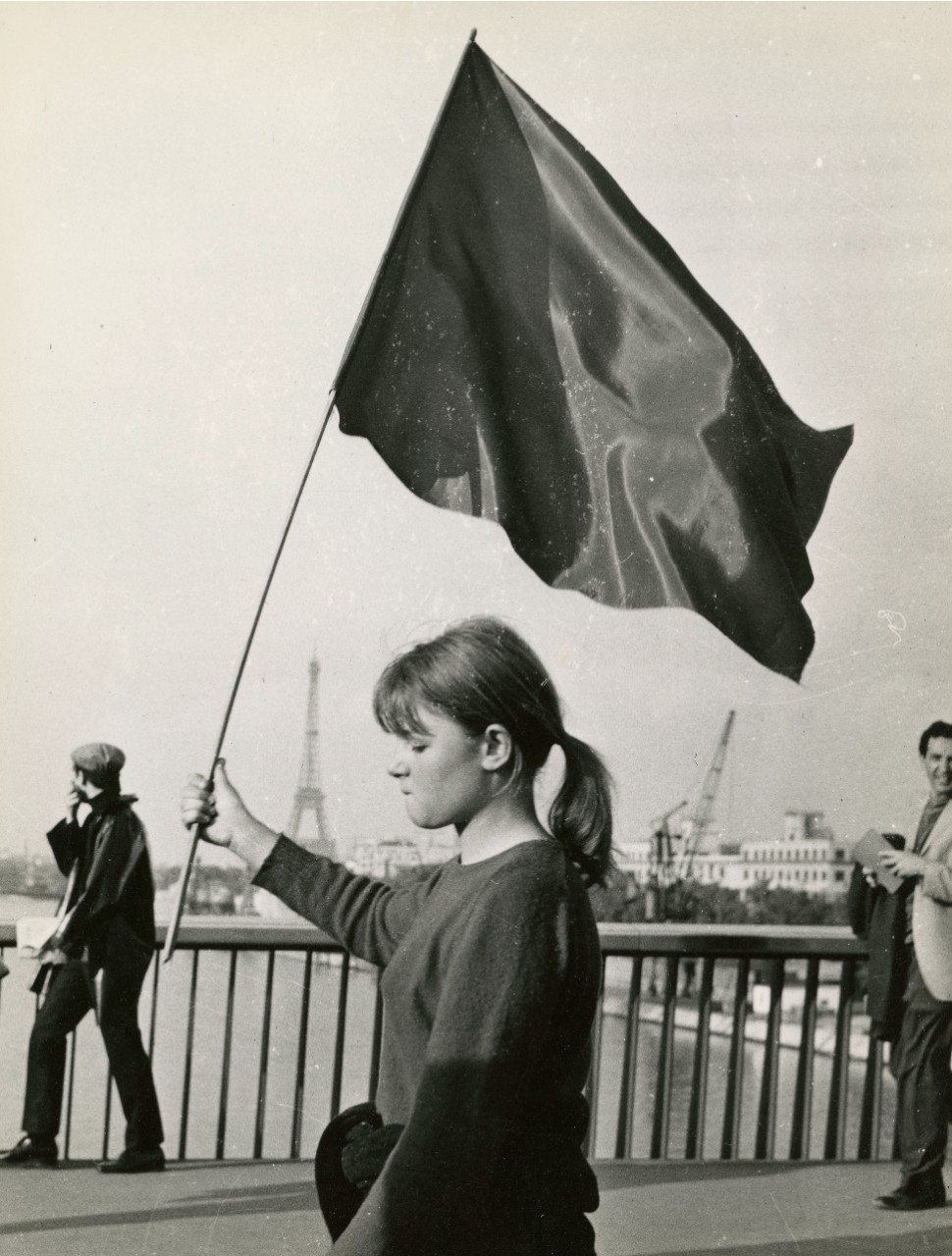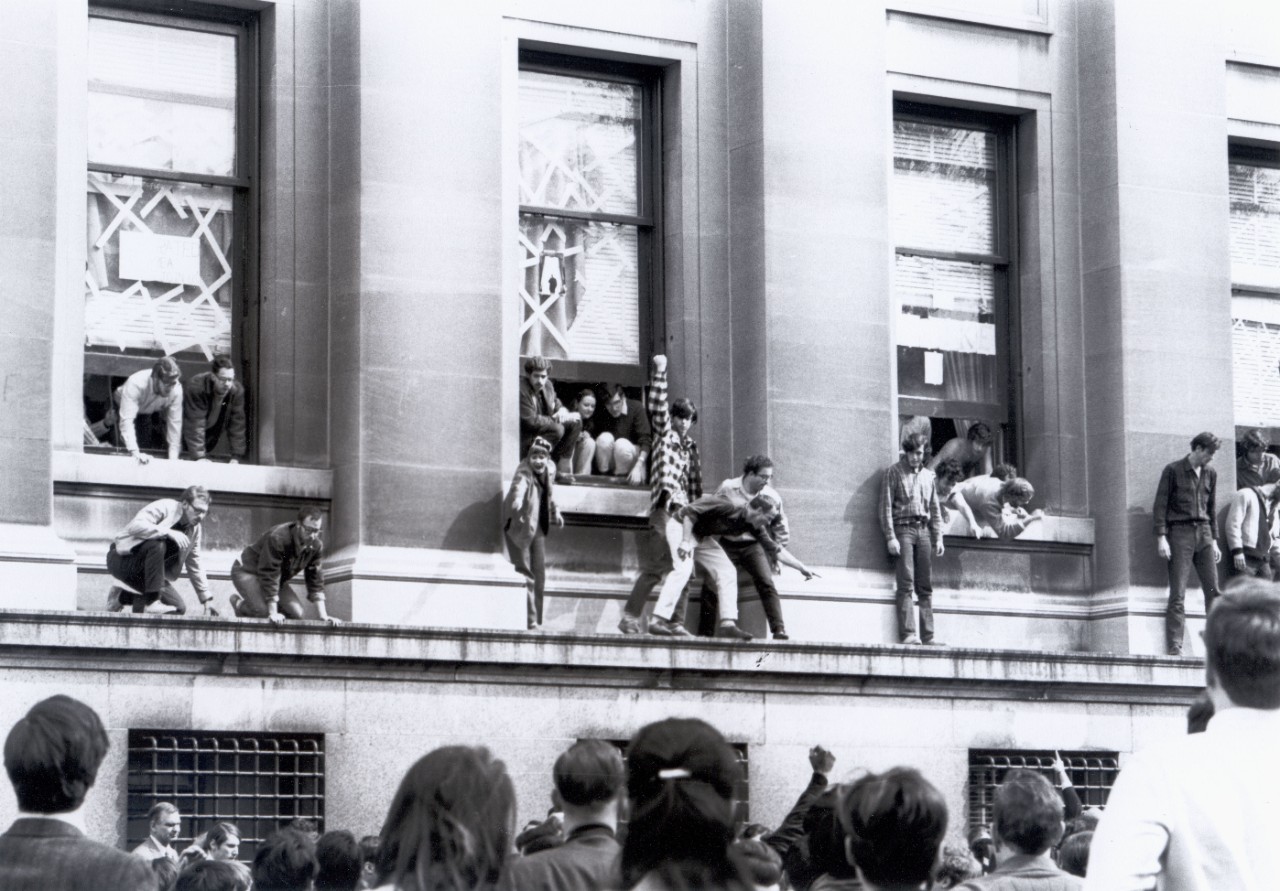Activism in the Archives
 Student and worker anger with the French state’s foreign and domestic policies fomented a near-revolution in Paris in early May 1968. This photo of a young woman brandishing a protest flag in full view of the Eiffel Tower, that most iconic of Parisian sights, illustrates the sheer scale of civil unrest throughout the metropolis. (Anonymous, 'Photographs, 1968,' RBML General Manuscripts)
Student and worker anger with the French state’s foreign and domestic policies fomented a near-revolution in Paris in early May 1968. This photo of a young woman brandishing a protest flag in full view of the Eiffel Tower, that most iconic of Parisian sights, illustrates the sheer scale of civil unrest throughout the metropolis. (Anonymous, 'Photographs, 1968,' RBML General Manuscripts)
The national school walkout last month by students against gun violence provided a timely remembrance of Columbia University’s own history of student activism: the walkout took place on the same day, March 14, as a “moratorium” on classes at Columbia 50 years earlier, which was organized by students to protest the Vietnam War and accompanying military draft.
“In an era when protest has seen a revival among young people, the scenes of international mass resistance from 1968 are examples both of what protest can accomplish and its pitfalls,” said Lecturer and Lehman Curator for American History Thai Jones. “Aspects of the past continually speak to what’s important in the present.”
In recognition of the 50th anniversary of 1968, a year of widespread change that extended beyond American borders and around the world, Columbia’s Rare Book & Manuscript Library (RBML) organized a suite of events, exhibits, and resources to showcase the “global revolutions” of that pivotal year. The programming has provided an opportunity for Columbia students to engage directly with archival materials from the era and explore the legacies of young activists not unlike themselves.
“It’s been valuable to learn about the history of Columbia, in particular, as an institution in which students have been active voices for change,” said Olivia Rutigliano, a Ph.D. candidate in English and Comparative Literature who assisted Jones in curating “1968: The Global Revolutions,” a comprehensive exhibition of artifacts from the year’s many demonstrations and protests.
The exhibit benefited from the international range of RBML’s existing collections, and several recent acquisitions in American civil rights and Eastern and Western European history broadened the scope of the display even further. Though the curators’ primary intention in their selection of materials was to render a global perspective of 1968, for Rutigliano, “capturing the mood of the zeitgeist” was equally important.
“We chose the most attention-grabbing and thought-provoking images in order to show as many angles of the events as possible,” she said, referencing a series of photographs that show the intense conclusion of the 1968 campus protests at Columbia. “These details are necessary to the telling of these stories, no matter how startling.”
Activism at Columbia reached a fever pitch in April 1968, culminating in a weeklong series of sit-ins in campus buildings and a tense – and in some instances, violent – standoff between students, University administrators, and New York City police. The events sent shockwaves through the Columbia community, resulting in a number of changes to administrative policy and the establishment of a representative University Senate. Rutigliano and Jones borrowed from the extensive Protest and Activism Collection in RBML to demonstrate the toll of the protests on the University.
“Participants in the protests and people on campus at the time recognized that what was happening at Columbia was important and made a point to take photos and save news clippings, flyers, correspondence, press releases, and other papers,” said University Archivist Jocelyn Wilk, who is currently recounting the events through “live” reporting on Twitter. Archivists even uncovered a cache of photographs in a vault in Low Library in 2005 that had ostensibly been preserved by administrators in the 1960s.
“In an era when protest has seen a revival among young people, the scenes of international mass resistance from 1968 are examples both of what protest can accomplish and its pitfalls. Aspects of the past continually speak to what’s important in the present.”
– Thai Jones, Lecturer and Lehman Curator for American History
The trove of primary source materials held by RBML offers insight into decision-making by University administrators and the palpable frustration of the student body over military recruitment on campus, Columbia’s plans for expansion into Harlem, and other socio-political issues. The archives raise complex questions about the events that Jones asks students to address in his current course, “The ‘60s in the Archive.” For class, students selected a research topic that is supported by the resources in RBML and set to work in the archives, unraveling competing perspectives of the events and occasionally, finding commonalities with activists of the era.
“[Archival research] draws out questions that might not have been obvious through a digital resource - you are forced to think about how and why a physical object was deemed important,” said Anna Oprysko, ‘19GSAS, a student of Jones’s and an assistant in Avery Architectural & Fine Arts Library who has focused her work on response to the campus protests among members of Columbia’s architecture school.
The close study of fundamentally tangible materials – a bedsheet scrawled with protest slogans, handwritten letters to University administrators – is a research experience made possible by the curatorial foresight of librarians, archivists, and curators.
“There is an intimacy to physical texts that is inimitable,” said Opyrsko. “To see a yellowed poster and know it must have been hanging somewhere for a long time, or to read editorial marks and signatures in someone’s own hand, creates a bond with whatever research you might be doing. Investigation into events at the level of individual documents has made the events of 1968 more relatable; it is impossible to wave away what might have seemed like abstractions when interacting with personal history and tangible objects.”
(Featured image on News page: Crowds head to Low Library from the SAS/SDS sundial rally, April 23, 1968. Gerald S. Adler (GSAS'80), photographer, 1968.)
